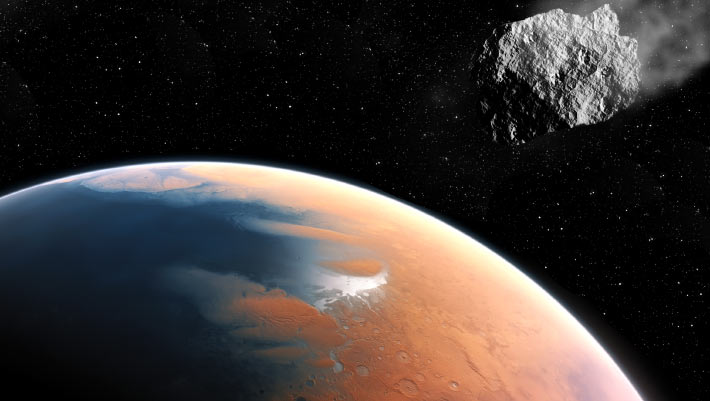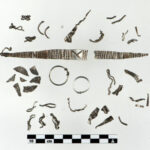The Chicxulub-like asteroid crash landed in shallow ocean waters in the Martian region of Chryse Planitia 3.4 billion years ago (Hesperian period) and left a crater about 110 km wide, according to new research led by Planetary Science Institute scientists.
An illustration of an asteroid on its way to ancient Mars. Image credit: M. Kornmesser / ESO / Nathan Owen-Price / Sci.News.
Previous research has proposed that an asteroid or comet impact within an ocean in the Martian northern lowlands may have caused a megatsunami approximately 3.4 billion years ago.
However, the location of the resulting impact crater was unclear, until now.
“In 1971, NASA’s Mariner 9 spacecraft discovered on Mars the first extraterrestrial landscapes of likely fluvial origin, including probable catastrophic flood channels of enormous proportions,” said Planetary Science Institute researcher Alexis Rodriguez and colleagues.
“Five years later, NASA’s Viking 1 Lander was the first spacecraft to operate successfully on the Martian surface.”
“The spacecraft landed near the terminus of an enormous catastrophic flood channel, Maja Valles. However, instead of the expected megaflood record, its cameras imaged a boulder-strewn surface of elusive origin.”
In their new study, Dr. Rodriguez and co-authors analyzed maps of the Martian surface, created by combining images from previous missions to the planet, and identified an impact crater that could have caused the megatsunami.
Dubbed Pohl, the crater has a diameter of 110 km and is located within an area of the northern lowlands that previous studies have suggested may have been covered by an ocean, in a region around 120 m below its proposed sea level.
The researchers suggest that Pohl may have formed around 3.4 billion years ago based on its position above and below rocks previously dated to this time.
They also simulated asteroid and comet collisions with this region to test what type of impact that could have created Pohl and whether this could have led to a megatsunami.
They found that the simulations that formed craters with similar dimensions to Pohl were caused by either a 9-km asteroid encountering strong ground resistance or a 3-km asteroid encountering weak ground resistance.
Both simulated impacts formed craters measuring 110 km in diameter and generated megatsunamis that reached as far as 1,500 km from the center of the impact site.
The analysis of the megatsunami caused by the 3-km asteroid indicated that this tsunami may have measured up to approximately 250 m tall on land.
“The aftermath of the proposed Pohl impact may have had similarities with the Chicxulub impact on Earth, which previous research has suggested occurred within a region 200 m below sea level, generated a crater with a temporary diameter of 100 km, and led to a megatsunami that was 200 m high on land,” the authors said.
Their paper appears today in the journal Scientific Reports.
_____
J.A.P. Rodriguez et al. 2022. Evidence of an oceanic impact and megatsunami sedimentation in Chryse Planitia, Mars. Sci Rep 12, 19589; doi: 10.1038/s41598-022-18082-2




